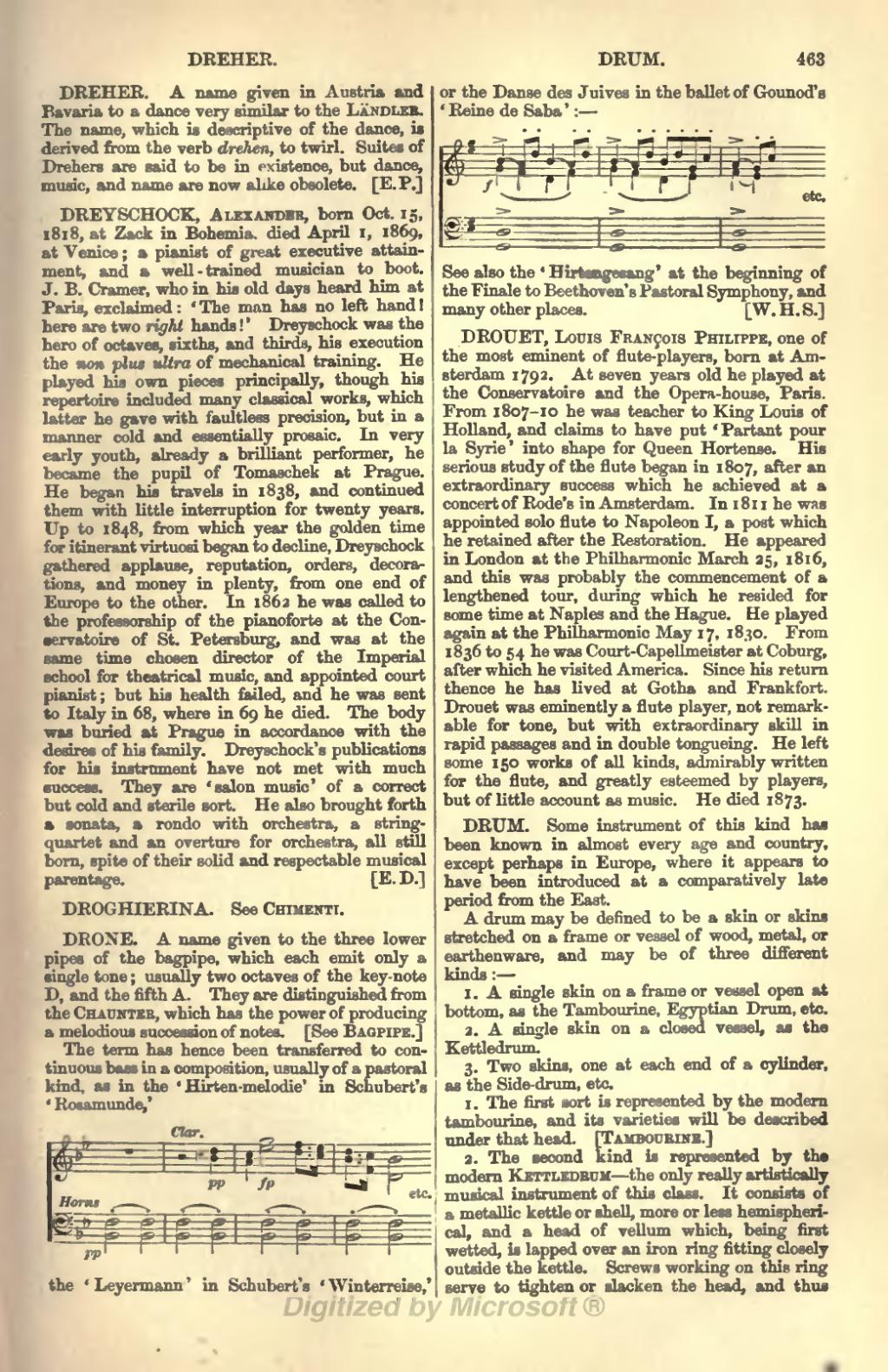DREHER. A name given in Austria and Bavaria to a dance very similar to the Ländler. The name, which is descriptive of the dance, is derived from the verb drehen, to twirl. Suites of Drehers are said to be in existence, but dance, music, and name are now alike obsolete.
DREYSCHOCK, Alexander, born Oct. 15, 1818, at Zack in Bohemia, died April 1, 1869, at Venice; a pianist of great executive attainment, and a well-trained musician to boot. J. B. Cramer, who in his old days heard him at Paris, exclaimed: 'The man has no left hand! here are two right hands!' Dreyschock was the hero of octaves, sixths, and thirds, his execution the non plus ultra of mechanical training. He played his own pieces principally, though his repertoire included many classical works, which latter he gave with faultless precision, but in a manner cold and essentially prosaic. In very early youth, already a brilliant performer, he became the pupil of Tomaschek at Prague. He began his travels in 1838, and continued them with little interruption for twenty years. Up to 1848, from which year the golden time for itinerant virtuosi began to decline, Dreyschock gathered applause, reputation, orders, decorations, and money in plenty, from one end of Europe to the other. In 1862 he was called to the professorship of the pianoforte at the Conservatoire of St. Petersburg, and was at the same time chosen director of the Imperial school for theatrical music, and appointed court pianist; but his health failed, and he was sent to Italy in 68, where in 69 he died. The body buried at Prague in accordance with the desires of his family. Dreyschock's publications for his instrument have not met with much success. They are 'salon music' of a correct but cold and sterile sort. He also brought forth sonata, a rondo with orchestra, a string-quartet and an overture for orchestra, all still born, spite of their solid and respectable musical parentage.
DROGHIERINA. See Chimenti.
DRONE. A name given to the three lower pipes of the bagpipe, which each emit only a single tone; usually two octaves of the key-note D, and the fifth A. They are distinguished from the Chaunter, which has the power of producing a melodious succession of notes. [See Bagpipe.]
The term has hence been transferred to continuous bass in a composition, usually of a pastoral kind, as in the 'Hirten-melodie' in Schubert's 'Rosamunde,'

etc.
the 'Leyermann' in Schubert's 'Winterreise' or the Danse des Juives in the ballet of Gounod's 'Reine de Saba':—

See also the 'Hirtengesang' at the beginning of the Finale to Beethoven's Pastoral Symphony, and many other places.
DROUET, Louis François Philippe, one of the most eminent of flute-players, born at Amsterdam 1792. At seven years old he played at the Conservatoire and the Opera-house, Paris. From 1807–10 he was teacher to King Louis of Holland, and claims to have put 'Partant pour la Syrie' into shape for Queen Hortense. His serious study of the flute began in 1807, after an extraordinary success which he achieved at a concert of Rode's in Amsterdam. In 1811 he was appointed solo flute to Napoleon I, a post which he retained after the Restoration. He appeared in London at the Philharmonic March 35, 1816, and this was probably the commencement of a lengthened tour, during which he resided for some time at Naples and the Hague. He played again at the Philharmonic May 17, 1830. From 1836 to 54 he was Court-Capellmeister at Coburg, after which he visited America. Since his return thence he has lived at Gotha and Frankfort. Drouet was eminently a flute player, not remarkable for tone, but with extraordinary skill in rapid passages and in double tongueing. He left some 150 works of all kinds, admirably written for the flute, and greatly esteemed by players, but of little account as music. He died 1873 [App. p.618 "Sept. 30"].
DRUM. Some instrument of this kind has been known in almost every age and country, except perhaps in Europe, where it appears to have been introduced at a comparatively late period from the East.
A drum may be denned to be a skin or skins stretched on a frame or vessel of wood, metal, or earthenware, and may be of three different kinds:—
1. A single skin on a frame or vessel open at bottom, as the Tambourine, Egyptian Drum, etc.
2. A single skin on a closed vessel, as the Kettledrum.
3. Two skins, one at each end of a cylinder, as the Side-drum, etc.
1. The first sort is represented by the modern tambourine, and its varieties will be described under that head. [Tambourine.]
2. The second kind is represented by the modern Kettledrum the only really artistically musical instrument of this class. It consists of a metallic kettle or shell, more or less hemispherical, and a head of vellum which, being first wetted, is lapped over an iron ring fitting closely outside the kettle. Screws working on this ring serve to tighten or slacken the head, and thus
